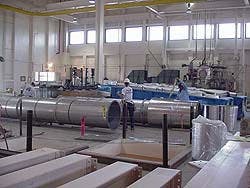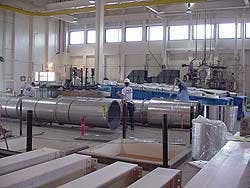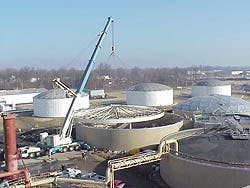Alternative Solids Process to Reduce Odor, Save Money
Black & Veatch has announced that its Alternative Solids Process design for Kentucky's largest municipal wastewater utility, the Louisville & Jefferson County Metropolitan Sewer District (MSD), is saving the utility millions of dollars and reducing odors in the community.
The 43-year-old, 105 mgd Morris Forman Wastewater Treatment Plant is located less than 10 miles from Louisville's downtown business district in a largely industrial sector, although many residential neighborhoods are nearby. In addition to treating its own solids, the plant also processes solids from other MSD wastewater treatment plants. Importing solids from other facilities made the plant a lightning rod for neighborhood activists concerned by its odors.
In April 2000, MSD chose the Black & Veatch Corp. and J.S. Alberici Construction Co. Joint Venture to design and construct a new process for solids treatment at the Morris Forman plant. The contract for the project, $64.6 million, is the largest in MSD's history.
"We've found that the design-build approach takes less time, saves money and provides opportunities for more creative approaches that add value to the project," said MSD Executive Director Gordon R. Garner.
The result is a project that cost nearly $32 million less than MSD had initially estimated, is expected to save more than $4 million a year in operation and maintenance costs, provides a fertilizer product that MSD can use, and reduces landfill disposal volume by 50 percent.
Processing and disposing of solids have been expensive, and smelly, challenges for wastewater utilities throughout the U.S., according to Blake Childress, Black & Veatch project director for the MSD project.
"Many plants have historically used incineration for solids, but odor, air quality and disposal issues exist with this method," Childress said. "Heat drying is increasingly preferred as an alternative to incineration."
Creativity Saves Time, MoneyThe Alternative Solids Process Black & Veatch designed for MSD replaces a low-pressure oxidation system that has been in use since the 1970s.In the new process, primary solids will be anaerobically digested and blended with thickened waste-activated sludge in four refurbished digesters. Digester gas will be used to offset a major portion of the energy needs for drying, and waste heat from the dryers will be used to heat the digesters. The solids from the digesters are de-watered in the new high-solids centrifuges with sufficient capacity to dewater the plant's entire solids production.
The dewatered sludge will then be fed into the four heat-drying trains, each with an evaporative capacity of more than 8,500 Kg/hr. The drying trains are state-of-the-art, triple-pass drum design. Each drying train is equipped with a polycyclone to separate solids and an impingement tray scrubber/condenser to cool the off-gases. Final off-gases are treated in a venturi scrubber and a regenerative thermal oxidizer for VOC destruction.
Dried biosolids pellets, ranging in size from 1 to 4 mm, will be transferred into renovated ash silos for truck loading. When completed, the installation will make the Morris Forman plant among the largest heat drying facilities in the world in terms of installed capacity.
During project planning, the Joint Venture team found ways to use existing structures at the plant to house the process, totally enclosing the dryers to minimize odor and reduce construction costs. The team is working with MSD operations staff to update and restore four existing anaerobic digesters instead of building new ones.
In addition, the project team scaled up heat-drying technology to minimize the number of dryers required. This approach also contributed to procurement and construction savings.
To maximize the project's long-term impact on MSD, plans call for using methane gas produced in the anaerobic digestion process to fuel the dryers. The dried biosolids pellets that result from the process can be used as fertilizer or safely disposed at a commercial landfill. WW/


